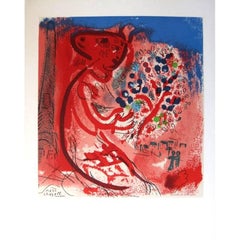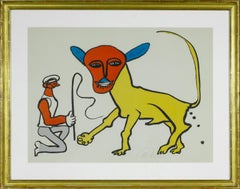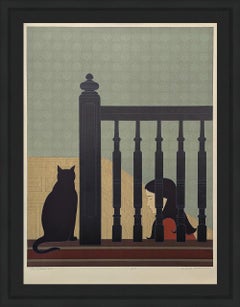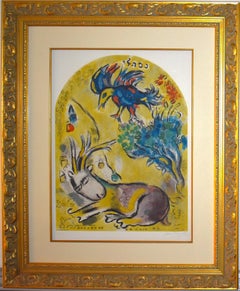(after) Marc Chagall Animal Prints
French, Russian, 1887-1985
Marc Chagall was a renowned Jewish artist born July 7, 1887, in Vitebsk, Russia, who later moved to Paris and gained French citizenship. Chagall studied at the Imperial Society for the Protection of the Arts in Saint Petersburg. He was a member of the Ecole de Paris and was part of the Salon des Indépendants and the Salon d’Automne in the early 1900s. In addition to Paris and St. Petersburg, Chagall traveled and exhibited globally including Amsterdam, Jerusalem, and New York City. Having lived through World War I and World War II, his work was influenced by these events. Chagall’s work is inspired by his Jewish heritage and his hometown of Vitebsk and incorporates elements of Fauvism and Cubism as well as aspects of traditional Russian and Jewish folk art. His work has been exhibited and collected internationally both privately and by institutions including the Guggenheim, the Museum of Modern Art, Centre Pompidou, and Tate Modern.to
3
Overall Width
to
Overall Height
to
2
1
70
194
160
119
94
3
3
3
3
3
3
2
2
1
3
3
Artist: (after) Marc Chagall
Femme au bouquet de fleurs (Lady with Flower Bouquet)
By (after) Marc Chagall
Located in Collonge Bellerive, Geneve, CH
This vintage color lithograph on paper is after a watercolor by Marc Chagall titled Femme au bouquet de fleurs (Lady with Flower Bouquet). Signed on ...
Category
1960s Surrealist (after) Marc Chagall Animal Prints
Materials
Lithograph
After Marc Chagall - Lithograph
By (after) Marc Chagall
Located in Collonge Bellerive, Geneve, CH
After Marc Chagall - Lithograph
From the deluxe art review, Derrière le Mirroir, printed by Charles Sorlier
1964
Printed signature
Dimensions: 38 x...
Category
1960s Modern (after) Marc Chagall Animal Prints
Materials
Lithograph
Marc Chagall (after) - Lettre à mon peintre Raoul Dufy
By (after) Marc Chagall
Located in Collonge Bellerive, Geneve, CH
(after) Marc Chagall
Lithograph after a watercolor, published in the book "Lettre à mon peintre Raoul Dufy." Paris, Librairie Académique Perrin, 1965.
Printed signature
Dimensions:...
Category
1960s Surrealist (after) Marc Chagall Animal Prints
Materials
Lithograph
Related Items
"Lion Tamer" framed signed lithograph by Alexander Calder. Edition EA of 100.
By Alexander Calder
Located in Boca Raton, FL
"Lion Tamer" lithograph by Alexander Calder. Hand-lettered EA in lower left front corner. Hand-signed Calder in lower right front corner. From an ed...
Category
1970s Modern (after) Marc Chagall Animal Prints
Materials
Lithograph
$12,000
H 31 in W 39.25 in
THE BANNISTER
By Will Barnet
Located in Aventura, FL
Lithograph on arches paper. Hand signed, dated titled and numbered in pencil by the artist. From the deluxe edition of 125. Image size 32 x 25 inches. Sheet size 36 x 26.5 inches. ...
Category
1980s Contemporary (after) Marc Chagall Animal Prints
Materials
Paper, Lithograph
Original 1919, Give the World The Once Over in the United States Navy poster
Located in Spokane, WA
Original 1919 Give The World The Once Over in the United States Navy vintage poster. Archival linen backed. This poster presents itself very fine condition. The lower text por...
Category
1910s American Modern (after) Marc Chagall Animal Prints
Materials
Lithograph
$2,998
H 42 in W 28.5 in D 0.05 in
Lait Pur de la Vingeanne Stérilisé, Young Girl, Cats, Vintage French Advertising
By Théophile Alexandre Steinlen
Located in Union City, NJ
Lait Pur de la Vingeanne Stérilisé is an offset lithographic print reproduced after the original 1894-95 Belle Epoque advertising poster created by Théophile Steinlen, printed using 4-color offset lithography on heavyweight archival paper. Lait Pur de la Vingeanne Stérilisé depicts a seated rosy cheeked young girl (the artist's daughter) wearing a long red dress sipping milk from a bowl as a group of envious animal friends - 3 cats...
Category
1980s Art Nouveau (after) Marc Chagall Animal Prints
Materials
Lithograph
$200 Sale Price
20% Off
H 35.25 in W 26 in
Contemporary Botanical Portrait. Original Print on Dibond 24/25. Luckily Alive
By Natasha Lelenco
Located in FISTERRA, ES
This limited-edition Dibond UV print belongs to Natasha Lelenco’s Fetiches series, an artistic exploration of portraiture intertwined with organic motifs. Numbered 24 of 25, each pri...
Category
2010s Surrealist (after) Marc Chagall Animal Prints
Materials
Metal
$170 Sale Price
20% Off
H 15.75 in W 11.82 in D 0.2 in
NEGRO ES BELLO II Signed Lithograph, Black Is Beautiful, Black Power Movement
By Elizabeth Catlett
Located in Union City, NJ
NEGRO ES BELLO II is an original limited edition lithograph created by the African-American woman printmaker and sculptor, Elizabeth Catlett using hand printmaking techniques on arch...
Category
Early 2000s Contemporary (after) Marc Chagall Animal Prints
Materials
Lithograph
$6,140
H 33.5 in W 25.25 in
SHOE SHOP Signed Lithograph, Cowboy Farrier, Horseshoe, White Horse, Western Art
By Conrad Schwiering 1
Located in Union City, NJ
SHOE SHOP by the American Western artist Conrad Schwiering, is a hand drawn limited edition lithograph(not a photo reproduction or digital print) printed using hand lithography techn...
Category
1980s American Realist (after) Marc Chagall Animal Prints
Materials
Lithograph
$384 Sale Price
22% Off
H 21.5 in W 29 in
“Europa and the Bull”
By Alvar Sunol Munoz-Ramos
Located in San Francisco, CA
You have to hand it to the bull. Not just taking Europa with his unassailable power (he is Zeus in disguise, after all) he brings along a retinue for his seduction of the beautiful P...
Category
1980s Modern (after) Marc Chagall Animal Prints
Materials
Paper, Lithograph
Reginald Wilson, Horses
By Reginald Wilson
Located in New York, NY
Although this work is titled Horses. It nice to think it could be (Horses in a Field in Woodstock, NY), but it was printed by Will Barnet at the Art Students League, about 1938, and Wilson, who visited Woodstock with Arnold Blanche...
Category
1930s American Modern (after) Marc Chagall Animal Prints
Materials
Lithograph
CIGAR Champion Horse Portrait Signed Lithograph Equine Art, Horse Racing History
By Jenness Cortez
Located in Union City, NJ
CIGAR - Champion Horse Portrait 1997 by the contemporary woman artist and distinguished realist painter Jenness Cortez, is an original hand drawn limited edition lithograph printed using hand lithography techniques on archival paper 100% acid free. CIGAR is a lifelike, realistic equine portrait depicting the superstar thoroughbred racehorse Cigar, who was two-time Horse of the Year winner, a member of the National Racing Hall of Fame, and arguably the greatest racehorse of the 1990s. CIGAR, a visually impressive handmade lithograph, displays an appealing neutral color palette in shades of warm copper brown, grays, and charcoal black on a light slate blue background.
Print size - 29.5" x 25", unframed, excellent condition, pencil signed by Jenness Cortez
Image Size - 26" x 21"
Edition size - 250, plus proofs
Year - 1997
Printer - JK Fine Art Editions Co., NJ
High quality hand drawn lithograph, classic equine portrait, sporting art print pencil signed by Ms. Cortez on lower margin, First-rate hand crafted print, not a commercially mass photo reproduced poster or digital reproduction.
ABOUT THE ARTIST:
Jenness Cortez is a mid-career artist with astonishing talent. Born 1944 in Indiana, Jenness Cortez began her formal art studies at the age of sixteen under the guidance of noted Dutch painter, Antonius Raemaekers...
Category
1990s Realist (after) Marc Chagall Animal Prints
Materials
Lithograph
Jenness CortezCIGAR Champion Horse Portrait Signed Lithograph Equine Art, Horse Racing History, 1997
$396 Sale Price
41% Off
H 29.5 in W 25 in
Zephyr Bird, Lithograph by Joan Miro 1956
By Joan Miró
Located in Long Island City, NY
An original lithograph from the 1956 Derriere le Miroir “Miro-Artigas” folio. Printed by Mourlot, Published by Maeght, Paris.
Artist: Joan Miro, After, Spanish (1893 - 1983)
Title: Zephyr Bird...
Category
1950s Modern (after) Marc Chagall Animal Prints
Materials
Lithograph
INTEGRACION Signed Lithograph, Abstract Portrait, Latin American Woman Artist
By Raquel Forner
Located in Union City, NJ
Raquel Forner (1902-1988) Argentine woman painter and printmaker born in Buenos Aires in 1902 and died in the same city in 1988, regarded as one of the best Argentine female painters...
Category
1980s Expressionist (after) Marc Chagall Animal Prints
Materials
Lithograph
Previously Available Items
The Tribe of Naphtali, from The Jerusalem Windows
By (after) Marc Chagall
Located in Washington, DC
Artist: Marc Chagall (after)
Medium: Lithograph on Arches wove paper
Title: The Tribe of Naphtali
Portfolio: The Jerusalem Windows
Year: 1964
Edition...
Category
1960s (after) Marc Chagall Animal Prints
Materials
Lithograph
(after) Marc Chagall animal prints for sale on 1stDibs.
Find a wide variety of authentic (after) Marc Chagall animal prints available for sale on 1stDibs. If you’re browsing the collection of animal prints to introduce a pop of color in a neutral corner of your living room or bedroom, you can find work that includes elements of pink and other colors. You can also browse by medium to find art by (after) Marc Chagall in lithograph and more. Much of the original work by this artist or collective was created during the 1960s and is mostly associated with the Surrealist style. Not every interior allows for large (after) Marc Chagall animal prints, so small editions measuring 10 inches across are available. (after) Marc Chagall animal prints prices can differ depending upon medium, time period and other attributes. On 1stDibs, the price for these items starts at $1,331 and tops out at $1,442, while the average work can sell for $1,442.
Questions About (after) Marc Chagall Animal Prints
- Who is Marc Chagall?1 Answer1stDibs ExpertMarch 22, 2022Marc Chagall was a painter, illustrator, glass artisan, print maker and set designer who made a lasting impact on modern art. He was born on July 7, 1887, in Liozna, Belarus, and died on March 28, 1985, in Saint Paul de Vence, France. On 1stDibs, shop a selection of Marc Chagall art.
- What inspired Marc Chagall?1 Answer1stDibs ExpertMarch 22, 2022Many artists and things inspired Marc Chagall. Historians believe that his Jewish heritage and his hometown of Liozna, Belarus, served as sources of inspiration throughout his life. His work also displays the influence of surrealist, cubist, symbolist and fauve artists. On 1stDibs, shop a variety of Marc Chagall art.
- Where did Marc Chagall live?1 Answer1stDibs ExpertMarch 22, 2022Marc Chagall lived many places over the course of his life. He was born in Liozna, Belarus, on July 7, 1887. When he began working as an artist, he lived and worked in Saint Petersburg, Russia; Paris, France; and Berlin, Germany. During World War II, he relocated to the U.S. and then returned to Paris where he primarily resided until his death in 1985. On 1stDibs, find a variety of Marc Chagall art.
- What is Marc Chagall famous for?1 Answer1stDibs ExpertMarch 26, 2024Marc Chagall is famous for his art. He is one of the best known artists of the 20th century.
Chagall produced magnificent stained-glass windows for structures in France, Israel, Germany and the United States, and his lively paintings of Paris are revered all over the world. The Russian-French modernist worked in nearly every artistic medium. Influenced by Symbolism, Fauvism, Cubism and Surrealism, Chagall developed his own distinctive style, combining avant-garde techniques and motifs with elements drawn from Eastern European Jewish folk art.
Find authentic Marc Chagall prints and paintings on 1stDibs. - 1stDibs ExpertApril 5, 2022One of Marc Chagall’s most known works is entitled I and the Village. His style mixes bold colors in both the cubism and fauvism style. Shop a selection of Marc Chagall’s pieces from some of the world’s top art dealers on 1stDibs.
- How do I pronounce Marc Chagall?1 Answer1stDibs ExpertMarch 22, 2022To pronounce Marc Chagall, say "Mark Shu-GALL." The artist's real name was Moishe Shagal. Although the artist changed his name, he referenced his heritage in many works by including fish to represent his father who worked as a herring merchant. Shop a variety of Marc Chagall art on 1stDibs.
- How do I collect Marc Chagall?1 Answer1stDibs ExpertMarch 26, 2024To collect Marc Chagall art, seek out works from well known and respected sources. When it comes to making an investment of any kind, it’s important to conduct research and only work with reputable sellers. You can shop the collections of art dealers, auction houses and trusted online platforms to find authentic Marc Chagall paintings, prints and other works.
There are many reasons to collect art. A meaningful collection of art should help a residence feel more like itself. Buy art that speaks to you. Take your time when you’re shopping for art, and choose works that will resonate with you.
Shop Marc Chagall art on 1stDibs. - When was Marc Chagall born?1 Answer1stDibs ExpertMarch 22, 2022Marc Chagall was born on July 7, 1887, in Liozna, Belarus. He was an influential artist who worked in a variety of mediums, including paint, stained glass and illustrations. Chagall died on March 28, 1985, in Saint Paul de Vence, France. On 1stDibs, find a collection of Marc Chagall art.
- Where was Marc Chagall born?1 Answer1stDibs ExpertMarch 22, 2022Marc Chagall was born in Liozna, Belarus on July 7, 1887. He went on to become one of the most influential artists of the 20th century, creating works that drew from the movements of Cubism, Surrealism and Fauvism. On 1stDibs, find a selection of Marc Chagall art.
- 1stDibs ExpertMarch 26, 2024Marc Chagall used a variety of materials in his art. The Russian-French modernist worked in nearly every artistic medium. Influenced by Symbolism, Fauvism, Cubism and Surrealism, Chagall developed his own distinctive style, combining avant-garde techniques and motifs with elements drawn from Eastern European Jewish folk art.
Chagall produced magnificent stained-glass windows for structures in France, Israel, Germany and the United States. Additionally, his lively paintings of Paris are revered all over the world. Chagall had created etchings of Russian life during the 1920s but would explore printmaking later more deeply, during the 1950s, when he sought guidance from veteran lithographer Charles Sorlier, who became a friend and collaborator.
Find authentic Marc Chagall art on 1stDibs. - 1stDibs ExpertMarch 26, 2024Marc Chagall’s body of work is quite big. Over the course of his 75-year career, Chagall created approximately 10,000 pieces, including prints, paintings, book illustrations, stained glass windows and more.
The Russian-French modernist worked in nearly every artistic medium, and Chagall’s vibrant and densely colorful prints are known around the world. Characterized by a bold color palette and whimsical imagery, his works are often narrative, depicting small-village scenes and quotidian moments of peasant life, as in his late painting The Flight into Egypt from 1980.
On 1stDibs, find a selection of Marc Chagall art. - Did Marc Chagall use oil paint?1 Answer1stDibs ExpertMarch 22, 2022Yes, Marc Chagall used oil paint to produce many of his paintings. He also worked with gouaches and watercolors. Not just a painter, Chagall made stained glass windows, illustrations, prints, ceramics and other types of works throughout his life. Find a collection of Marc Chagall art on 1stDibs.
- 1stDibs ExpertMarch 26, 2024Yes, Marc Chagall personally signed some of his bookplates. Other bookplate illustrations created by the artist bear a reproduction of his signature. Many of the signed versions come from the collections of notable historical figures, including Nicholas II, the last Russian czar. Find signed Marc Chagall lithographs on 1stDibs.
- 1stDibs ExpertMarch 22, 2022Yes, Marc Chagall migrated to the United States. The Jewish artist fled Europe during World War II, moving to New York City in 1941. He settled in France in 1947 and lived there until he died in 1985. On 1stDibs, shop a range of Marc Chagall art.
- 1stDibs ExpertSeptember 28, 2021A Marc Chagall painting is likely worth anywhere between $50,000 to $70,000 according to current estimates. Marc Chagall is a Russian-French artist of Belarusian Jewish origin who is credited to be among the pioneering modernists. Adept in several styles and techniques, Chagall was best-known for creating stain-glass, tapestries and murals apart from paintings. On 1stDibs, find a variety of Marc Chagall paintings.
- 1stDibs ExpertFebruary 7, 2024Marc Chagall painted around 10,000 works during the course of his 75-year career. The Russian-French modernist worked in nearly every artistic medium. Influenced by Symbolism, Fauvism, Cubism and Surrealism, he developed his own distinctive style, combining avant-garde techniques and motifs with elements drawn from Eastern European Jewish folk art. On 1stDibs, find a selection of Marc Chagall art.
- 1stDibs ExpertMarch 26, 2024Yes, Marc Chagall worked in the Expressionist style, but he is associated with a range of modes and was inspired by various styles.
Chagall's lithographs as well as his other prints and paintings widely influenced the fantastic imagery of Surrealism and other movements of the 20th century. Known for his dreamlike creations inspired by folk art, Chagall drew on the colors and forms introduced by Cubism and Fauvism for a distinctive style all his own.
Expressionist artists experimented in paintings and prints with skewed perspectives, abstraction and unconventional, bright colors to portray how isolating and anxious the world felt rather than how it appeared. You can certainly detect the trademark bright colors and dramatic, exaggerated brushstrokes of Expressionism reflected in Chagall’s works such as his Vision of Paris and I and the Village.
Find a selection of Marc Chagall art on 1stDibs. - Where are the Chagall windows?1 Answer1stDibs ExpertApril 5, 2022Marc Chagall’s stained glass windows can be seen in a variety of places in Europe, Israel and the United States. There were 86 windows in total, and they can be found in New York, USA; Zurich, Switzerland; Mainz, Germany; Tudeley, UK; West Sussex, UK; and Chicago, USA. Shop a selection of Marc Chagall pieces from some of the world’s top art dealers on 1stDibs.
- 1stDibs ExpertMarch 20, 2024Clothing created for the Marc by Marc Jacobs line was reported to run large according to buyers. Award-winning American designer Marc Jacobs introduced Marc by Marc Jacobs in 2001. The diffusion line was a quirky collection that offered sportswear, drew on military style and streetwear, and targeted fashion-conscious consumers who sought affordable garments. While it was shuttered and folded into the designer’s main brand in 2015, Jacobs has since gone on to introduce beauty, fragrance and children’s lines. Shop vintage Marc by Marc Jacobs clothing and accessories on 1stDibs.
- 1stDibs ExpertApril 5, 2022Andrew Marc and Marc Jacobs are both American designers who have a strong connection to New York City. The Marc Jacobs line of clothing features high-end and quality ready-to-wear garments, handbags, accessories, shoes and fragrances. Andrew Marc is mainly known for making premium leather jackets and high-end outerwear. Shop a collection of Marc Jacobs from some of the world’s top sellers on 1stDibs.





